I have hunted sambar deer for over 50 years in the Gippsland mountains (and elsewhere other deer). Mostly I did it because it was fun and an excuse for a day out in the bush which I love. I still prefer lamb, and having been a sheep farmer for just as long, I always had plenty on hand. These days (I am 73) I rarely shoot the deer I see, and I see many – more than half a dozen a day usually, and I hardly ever bother any more to hunt the mornings and evenings. If I did, I would see over a dozen a day I guess!
NB: This post was written specifically as a request for a novice hunter who contacted me for advice.
NB2: Check out my new post Hunting Tales & Responsible Sambar Deer Hunting
I prefer to get where I am going mid afternoon, make camp, enjoy a fire, a good book, perhaps some music, maybe catch a fish, a lie in mornings…Anyway, it is good to make it to camp, get the tent pitched, collect the wood, lay the fire (unless it’s raining – in which case the kindling is in the tent), perhaps hang your pack out of reach of dingoes, then have the last 1-2 hours of daylight for hunting the river bottoms; that is when the deer will be coming down to feed (and drink). Then hunt the first hour or two of daylight before the deer creep off to bed, that is if you rise at dawn – me, I sleep in now – that way I have avoided being hanged many times!. Mind you some folk swear by these: http://www.theultralighthiker.com/solunar-tables/
For more about Deer Hunting tents See DIY Tents
Tiny our oldest Jack Russell loved deer – she liked them cut up a little smaller though – mind you when I did so (for her) she promptly buried them, imagining (at 13) she would pass this way again. Dogs, it seems share our delusions… As it turns out she has been back for other visits, and lived to be 18 (2018)! She was enjoying a canoe trip down the Wonnangatta only a couple of weeks before she died.
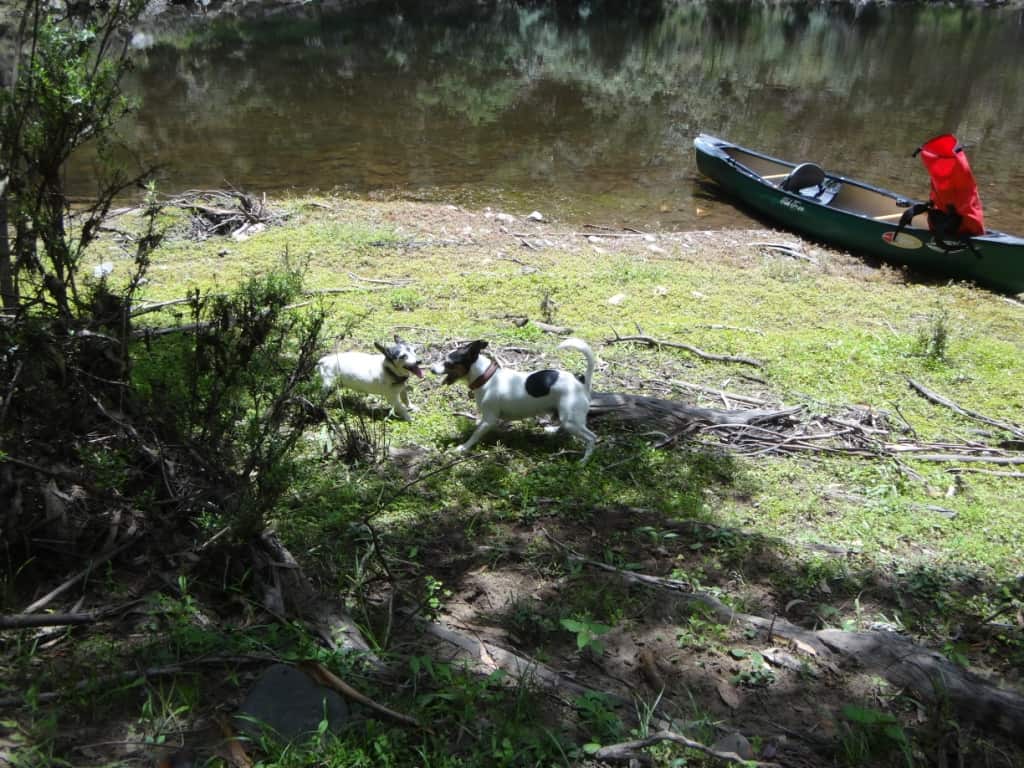
The Jack Russell is the pocket knife of the canine world – you should always have one about on or near your person!
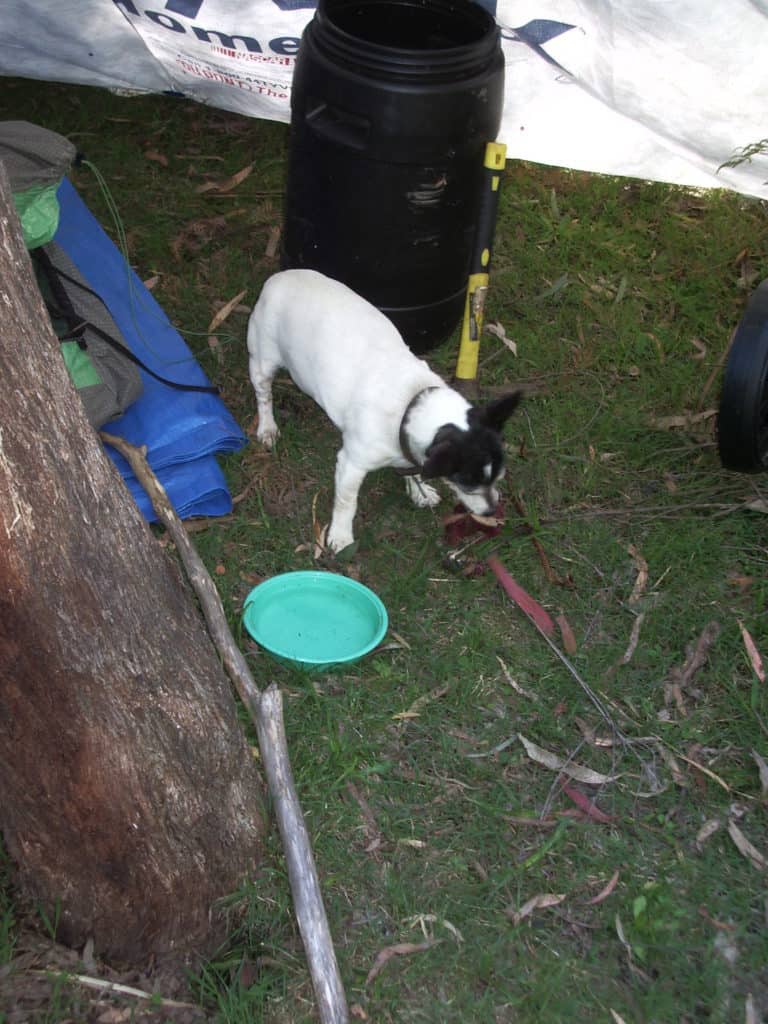
Tasty she said, and then snuggled up in my sleeping bag for a snooze. The dry food is rejected.
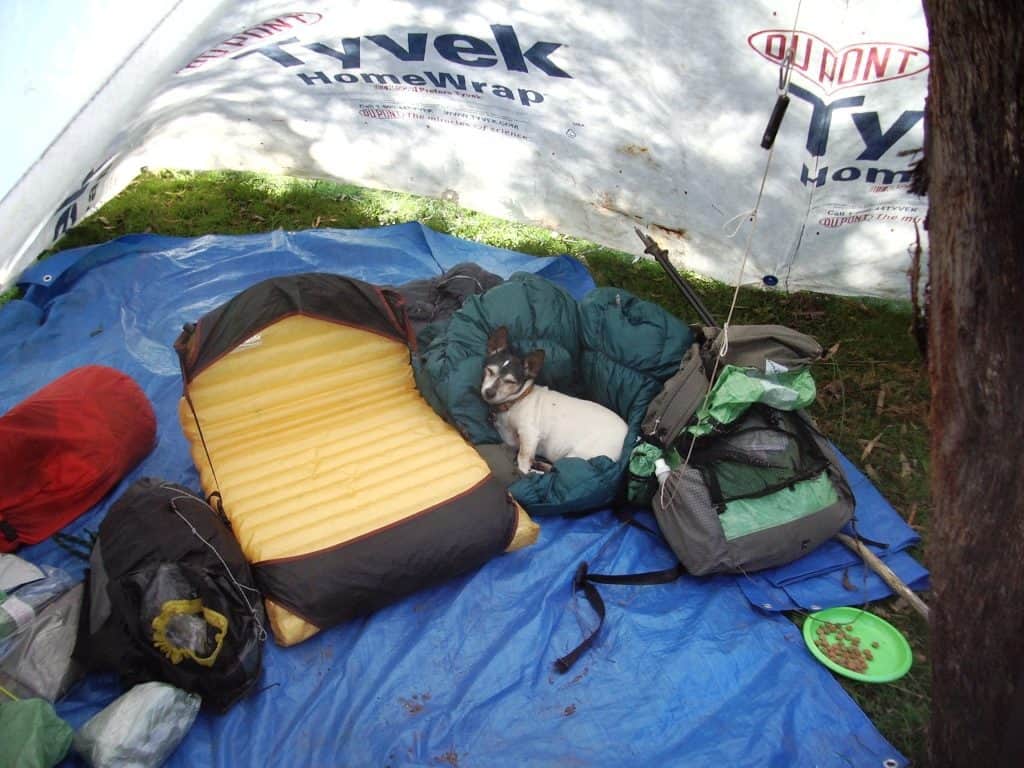
Long before you venture into the bush to hunt or do anything, first you need to know how to survive in the bush, how to not stay lost, how to make a shelter and light a fire in the rain…how to be comfortable there. You might benefit from a perusal of my many thoughts on this here: Ultralight Survival Made Easy
I will soon, as often promised, get up a Gear List, but I am sure you can guess at most of it in the above link. Also See eg: Backpacking Gear Advice & Ultralight Hunting Daypack Update & Ultralight Pack & A Gorilla in the Hand & The Ultralight Deer Hunter
First you need to go where there are lots of deer. Deer are lazy just like everyone else, and don’t want to travel too far for a feed, so there will be lots of them where the feed is best. The feed is best just where it is best for normal livestock: creek & river flats and improved pasture on private land – or what was once private land (eg the Wonnangatta National Park), the east side of North facing gullies, any clearing, particularly regrowth burnt areas & etc. The bush above clear paddocks always has bedded deer. Often there is a 4WD track in turn above it. Very handy.
Deer love areas around water supply catchment dams for the same reason (eg Thomson, Upper Yarra, Moondarra, etc.) When the Thomson was low, you could literally see herds of them (50+) at dusk coming down to graze on the clear dam bottoms. The reek of them at the forest edge was unbelievable. Of course the forest areas surrounding are often too thick to hunt them (even if legal).
They also love to colonise fresh burns and logging coups in larger numbers, and naturally their numbers are highest at the ‘peak’ of their ‘wave’ eg where they are moving into far East Gippsland. The regrowth burns on the Snowy should be great places to observe them this season – though it is not legal to hunt them in that area of the Alpine National Park (yet – if ever).
You can check Google Earth for suitable spots in conjunction with Victopo maps and the GMA maps showing where you can legally hunt. Usually I prefer more gentle slopes now, but I used to delight in the steepest country because no-one else hunted it!
I have found that just over half a day’s walk from where you can park a car the deer become much less timid. Up to that point they will honk and run away. 300 metres beyond that point they will often just stand and look at you. I love to stand/sit and watch hinds and fawns playing in a family setting.
I prefer overnight trips/hunts anyway, or multiple days. It is easy enough to carry a week’s dry tucker (@ 500 grams per day, A Hiking Food Compendium and everything else you could need in a pack weighing about 10 kilos. Some good ideas here: Hammock Hunting Till Dark
You are bound to see more deer on an overnight hunt because you don’t have to leave early to get back to your car before total darkness. You will also likely have only an easy, flat walk to your camp in the twilight. Dusk is a magic time. These may come in handy: Hunbting Thumbtack Reflectors
Deer will almost invariably come by and make all sorts of noises within a chain of your camp (if you are alone/quiet) during the night. You could easily shoot them even in the light of the The Nano Torch I wrote about the other day (700 lumens & 15 grams), as it is enough to light up their eyes.
I never shoot at night. First, you don’t really know what you are shooting at, particularly if you miss. Second, if you take a shot and wound an animal, it will suffer horribly before you can possibly locate it (unlikely). I once found a spiker whose lower jaw had been shot clean off by spotlighters, and which had suffered dreadfully for many days. Its face was flyblown. It was moaning. If you want to drive around at night to observe deer, that is another matter. The Upper Thompson Rd rarely fails to provide encounters, as do many others.
So, go where there are lots of deer. It is best if the bush is not too thick. You can also pick this up from Google Earth. Sometimes there are fire tracks not shown on current Victopo maps, (If you can get hold of the older maps, do), or old closed tracks which give access to less frequented country often on foot or by mountain or motorbike – or illegally. ometimes you will have to do a bit of machete work to clear a walking or cycling track, but it will pay off.
A canoe can also provide great access – and a way to get the meat out! See: You Take the High Road and I’ll Take the Low I prefer not to run into other folks when hunting/hiking, so I usually hunt mid-week now, because I can, and never on holidays!
It is good if you can see through the bush. You need to train yourself to look through it anyway. Your eyes/brain naturally want to focus on the nearest objects which means you are not seeing the deer through the trees; you are just seeing the trees. You can practice looking through the cracks in paling fences as you walk around the town streets, or looking through hedges as you drive along until you are used to focusing on the things that are on the other side of the screen of vegetation. You have to look into the distance. You have to put your eyes out of focus. It is a trick worth learning.
Then too you will be better able to see the lie of the land, which is supremely important in finding your way and assessing a deer’s likely path. I can guarantee you that the critters which live in the bush always do this ie look through the bush – which is why they (almost) always see you first unless you are moving very slowly! Really thick bush is a pain anyway, and it will be harder to shoot a deer in it – unless you are hound hunting perhaps.
When a deer honks at you but doesn’t run off is an excellent opportunity to test your ability to see through the bush. You can guarantee it is watching you, and will respond to your every movement, so its eyes (at least) must be visible to you. Practice finding those eyes; maybe an ear: they will be behind vegetation perhaps, but are in clear view. Deer will stand still for an hour! Believe me, but they are also past masters at sneaking off!
Some folks have become ‘ambush predators’. They place camo cameras on trees near game trails, drinking spots and wallows, record the deer’s movements, then lie up in wait for them. Others have high powered scopes and ‘glass’ the opposite sides of valleys (up to a kilometre away) and shoot their deer long distance. I would find both these methods boring and unfair as well as despicable. I prefer to travel past lots of deer (and other things).
There is always something new to see and learn in the bush (new things which are blue for example, in a satin bird’s bower). I prefer to be moving. The ‘Theory of Searches’ notwithstanding, (see Robert Sheckley’s ‘Mindswap’), you will see more deer (where there are lots of deer), if you walk past more deer. You will also learn where they bed, and especially where they go in really bad weather. Important knowledge for middle of the day hunting and when it is cold and rainy but you still want to be ‘up the bush’. Tip: Learn where there are ‘perched gullies’.
In undisturbed areas, they often don’t travel far from where they feed. Sometimes no more than 200 metres (if that) uphill – I have found them lying asleep in a meadow where they have been feeding. (Look carefull at those ‘logs’!
They also like to sleep in spots where you would – if you had to live in the bush and had no man-made shelter, or protection from (potential) predators. They always have a view of their back trail; they like some cover but not so much they can’t see through it – particularly when they are lying down.
Hunt the faces during the day and the bottoms at the ends of the day. Stags particularly can still be about near their thrashing places and wallows in the middle of the day – especially if they are in rut. This (ie ‘rut’) is a smell you need to learn to recognise – as is the difference between stag and hind smell. Smell is very important, especially if like me you are very nearly deaf! See: Follow Your Nose
Mind you, sambar don’t usually make a lot of noise. If they are moving along normally, you are unlikely to hear them, save for the very occasional snapped twig or chink of stone, particularly when they are crossing a stream. Sometimes the clack of an antler against wood. Rarely, you will hear them wallowing, thrashing. Very rarely fighting. Or the preludes to fighting: howls very like an old hound. Sometime you will be challenged by a stag with such a call.
Do not think it is a hound (though it may be a dingo). A lost hound seldom howls. You can howl and they will howl back. You can spend an entertaining hour at this play. They have their warning honk, not unlike a car horn, and there are many small sounds passed between hinds and fawns which you will only hear when they are at play coming down to graze in the early evening – and if you are very close. Being deaf as I am is not so much of a disadvantage in sambar hunting.
Learn to ‘read’ deer sign: droppings, browse, rubs, thrashing, scrapes, preaching trees, combat zones, wallows, towel trees, drinking spots, tracks, paths, bedding spots…You need to learn not only how fresh it is but what it tells you about the deer’s life. After you see a deer always go and have a look at the tracks it made. This way you will learn what marks a particular kind of deer (eg stag/hind/young etc) makes and when sh/e makes them.
Following deer tracks can teach you much, though you are not specially likely to shoot a deer whose tracks you are following (unless it is very deep asleep (sometimes) or has little experience (eg of hunters). Concentrating on following the tracks will almost certainly mean you miss seeing the deer which made them (Keep looking through the bush), but you will learn much about its habits, how fast it is traveling, how big it is, (I followed a stag – my daughter saw it – on the Ben Cruachan Creek years ago whose stride was much longer than mine – almost a yard), how it travels the terrain, where it beds, where its nursery areas are, what it is doing (browsing, mating, fighting…) This will allow you to later predict where particular (types) of deer are likely to be.
During the day you are more likely to get a shot at them by dropping in from the side or above than from below. Learn to walk quietly but do not stress too much: they are used to things moving about in the bush – and being able to run away from them. Wallows are often found on flats about a chain inside and upstream river bends. Antlers can frequently be ‘fished’ from them. They mostly smell of stag. Fix the scent in your mind, and pay attention when you next smell it. Scent (that humans can smell) doesn’t carry far – less than 100 metres. Smell that? There is a stag in sight, maybe. Unfortunately they do leave their smell on other things.
Never carry a loaded gun. The breach should always be empty. Forget so-called ‘safety catches’. More people have been shot because of them than triggers! I always use a lever action rifle because I can load it as I swing it to my shoulder. You are much more likely to shoot a running deer than a standing one. I always use iron sights because most shots are close and because they remain accurate just about whatever happens to your gun, and it is easy to see the deer over them. You are likely to drop your gun on rocks some time. Everyone falls over. A dropped loaded gun can easily go off!
Make sure it IS a deer before you shoot. Early days everything looks like a deer (stumps, anthills, friends…) A missed deer can be shot another time; a dead friend missed a long time! A lever action also allows a quick follow-up shot should it be necessary. Theoretically, it should not – but I have put nine .30-06 rounds through the chest of a sambar stag at close range only to have it still standing there looking at me.
I was out of ammo by then, so decided to wrestle it to the ground and cut its throat. I am here: it is possible to do this – but don’t! This stag (in rut) had no heart or lungs left yet he was still alive and standing – and fought for his life to the end! How I love deer!
These days I use a .308 because it is lighter but will still make a deer just as satisfactorily dead as say, a much heavier (reloaded) .45-70, which I also own. My current gun is a take-down. This is handy when you don’t want to draw attention to yourself as a hunter, and when you need to put it in your pack because you are tired and want to use your hiking poles (I am old!), or you want to put it in a dry-bag because you are canoeing: Lots of good deer country can be accessed by canoe. You can take lots of supplies, stay quite a while in luxury – and it is easy to get the meat out! Oh, and there are fish, which I prefer to eat.
I never wear camo. I can pretty much tell that someone has been (or is at) ‘my’ hunting patch wearing camo from the behavior of the deer. People wearing camo really spook the deer. They will take days to return to their normal habits. This has nothing to do with the camo hunters shooting deer – they seldom do. Other deer do not run away because you have just shot a deer. You can shoot a deer here, then walk 300 metres and shoot another one. I surmise it is the spookiness to the deer of seeing the forest walking. Anyway, they seem always to make themselves a lot scarcer than if you are wearing ordinary clothes so that the deer can figure out what you are, ie some kind of animal like them.
Anyway, most of that camo hunting gear is just simply awful. It is (apart from being hideously expensive) typically heavy, sweaty, not at all waterproof, soaks up huge amounts of water, completely impossible to wash and dry in the field, cold, flammable, uncomfortable…Lightweight hiking gear is much better – only avoid blue as the only colour deer are supposed to be able to see is blue, which apparently sort of ‘glows’ for them – though I have shot a number of deer whilst wearing the shirt below! I mostly wear Columbia ‘Silver Ridge’ especially trousers myself, but their shirts are nice too. Years ago I always wore wool when it was thick and heavy (ex-army wool trousers for example. Wool is really good as it is warm when wet. Icebreaker (for example) has a range of finer wool clothing now which I wear all the time. For example, in the moose hunting post I am wearing Icebreaker Departure 2 shirt, undershirt, underpants and hat: From Dawn to Dusky Day 2
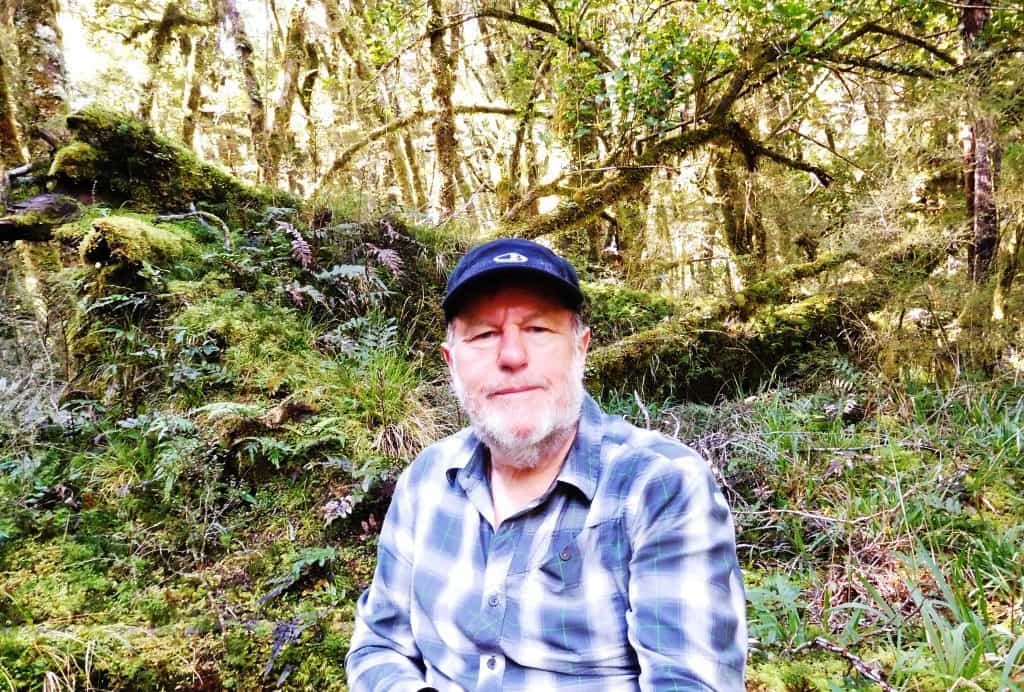
This photo was taken in Fiordland NZ during my recent 10 day walk. I was beautifully comfortable in this lovely wool clothing all the time even though it was mostly quite cold (and wet- as it usually is). It is excellent for deer hunting. It never stinks, is quick drying, warm and comfortable. Forget about the camo and specialized ‘hunting’ clothing. It is crap! Of course this shirt is blue – and there was a moose just about in sight when I took the photo! Read The Lure of the Moose
Deer will never see you when you are standing still. You can stand there all day; they will pass within yards of you – just spook when they whiff you! Most other wild animals are the same. It is laughably easy to creep up on a wallaby and catch it by the tail, for example. Just be still and bent over when they look at you.
Nowadays (it is legal) I always take (at least one of) my Jack Russells. They are better company than most people; (‘No company is better than bad company’ an old friend says). They are smart as a whip; they eat little and give much in return. They are easy to carry across rivers on your backpack. They require a very small sleeping bag and mat. They know long before you do that a deer is: just there. Deer are not inclined to run from them, but are fascinated by them – which means they are ignoring you! They enjoy you shooting a whole deer just for them!
Once you have done it a few times, you will easily be able to do it a few more. Forget about quietly sitting watching family groups of deer in the late afternoon with them around though. They will give the game away so that the deer behave differently. Deer will usually bail instantly for a Jack Russell when they would run from any other dog. Some dogs (the one above for example) snore however! Be warned.
PS: I have several times had feedback from this young chap. Most recently (Dec 2016) he wrote:
‘Hi Steve, just wanted to say thank you for the blog. It’s a fantastic resource, and I enjoy reading your posts – I’m sure the info has saved me many hours in the bush. This winter has been positive on the deer front. Managed to get out for a few trips – including 7 day backpack hunt into Wonnangatta Valley. This winter managed to get a ‘handle’ on deer hunting, and every trip out is a learning experience. Managed to shoot my first hind, and even a stag. Thank you for all your posts – you sure have saved me and my hunting mate lots of time, especially in terms of gear, and hiking/ultralight tips. We both ended hiking out of the Wonnangatta with 27+kg packs (took as much meat as possible); it’s remarkable how much a heavy pack slows you down. Also did a hunt a couple weeks ago ‘up the tops’ around Howitt High Plains – a different style of hunting for sure. Now it’s time to switch over to the trout, and grab the fly rod out. Have a week off work in two weeks and will be heading up upper Howqua area to fish Howqua, Jamieson and King. Apparently they are fishing well, so looking forward to it. Thanks a lot, keen to try out a few of your packraft routes soon too! Cheers!’
Another young fellow who has been following my advice sent me this wonderful photo:
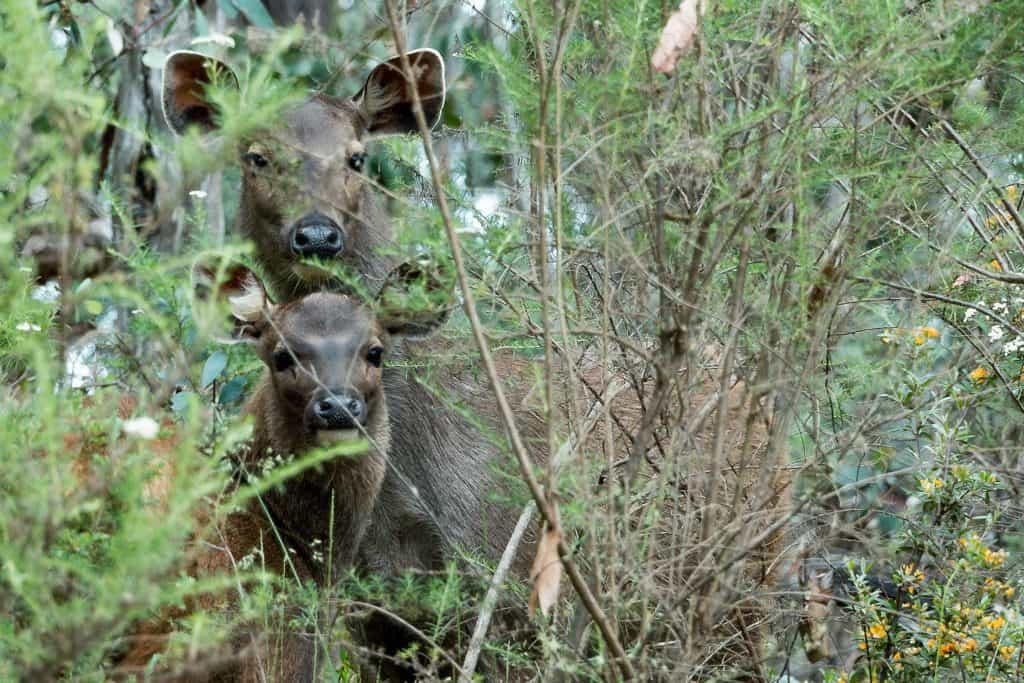
I am very pleased if my efforts are appreciated. Feel free to make (positive) comments or ask questions on the link provided here or on the Ultralight Hiker’s Facebook page which is broken at the moment and Facebook will not fix it. I will try to get back to you ASAP! I would also appreciate any other reader input such as gear tips, reviews, anecdotes, adventures, etc that I might publish.
An interesting link from a reader: https://animalko.com/things-that-make-the-sambar-deer-a-survival-specialist/
First Published on: Nov 30, 2019
NB2: Check out my new post Hunting Tales
First Published 15 June 2015. Updated 10-12/2019
For more about Tiny, see: A Tiny Life
See my newest hunting post here: The Valley of the Deer
Hunters might also like my new tent: Ultralight Poncho Tent
For more about Deer Hunting tents See DIY Tents
Or this:The Ultralight Deer Hunter
Some recent hunting related posts:
http://www.theultralighthiker.com/brer-fox/
http://www.theultralighthiker.com/the-ultralight-deer-hunter/
http://www.theultralighthiker.com/the-deer-hunters-apprentice-1/
http://www.theultralighthiker.com/the-lure-of-the-moose/
http://www.theultralighthiker.com/best-hunting-daypack/
http://www.theultralighthiker.com/ultralight-cookpot/
http://www.theultralighthiker.com/ultimate-blades-for-the-ultralight-hunter/
http://www.theultralighthiker.com/crkt-pdk-replacement-blades/
http://www.theultralighthiker.com/fire-umbrella/
http://www.theultralighthiker.com/are-you-beautiful-in-the-buff/
http://www.theultralighthiker.com/a-spot-of-solitude/
http://www.theultralighthiker.com/nz-moose/
http://www.theultralighthiker.com/follow-your-nose/
http://www.theultralighthiker.com/the-ultralight-fisherman/
http://www.theultralighthiker.com/hunting-thumbtack-reflectors/
Some Other Hunting Related Posts (there are many more):
Adventures:
http://www.theultralighthiker.com/thrilling-tales-sir-samuel-baker/
http://www.theultralighthiker.com/a-gorilla-in-the-bush/
http://www.theultralighthiker.com/hammock-hunting-till-dark/
http://www.theultralighthiker.com/no-sew-sandals/
http://www.theultralighthiker.com/gippsland-pack-rafting-routes/
http://www.theultralighthiker.com/you-take-the-high-road-and-ill-take-the-low/
http://www.theultralighthiker.com/wonnangatta-waterford-to-angusvale-day-one/
http://www.theultralighthiker.com/sambar-stalking-101/
http://www.theultralighthiker.com/sambar-deer-stalking-102/
http://www.theultralighthiker.com/sambar-deer-stalking-103/
http://www.theultralighthiker.com/sambar-deer-stalking-104/
http://www.theultralighthiker.com/the-silence-of-the-deer/
http://www.theultralighthiker.com/avon-river-walking-track/
http://www.theultralighthiker.com/does-spot-like-to-hunt-deer/
http://www.theultralighthiker.com/spots-hunting-adventures-1-mystery-river/
http://www.theultralighthiker.com/spots-adventures-mystery-river-2/
http://www.theultralighthiker.com/spots-hunting-adventures-mystery-river-3/
http://www.theultralighthiker.com/not-quite-alone-in-the-wilderness/
http://www.theultralighthiker.com/hammock-hunting-till-dark/
http://www.theultralighthiker.com/you-take-the-high-road-and-ill-take-the-low/
http://www.theultralighthiker.com/hammock-camping-double-bunking/
http://www.theultralighthiker.com/backpacking-gear-advice/
http://www.theultralighthiker.com/dusky-track-adventures-1/
http://www.theultralighthiker.com/dusky-track-canoeing-the-seaforth/
http://www.theultralighthiker.com/hunting-in-fiordland/
http://www.theultralighthiker.com/moose-hunting/
http://www.theultralighthiker.com/westies-hut/
http://www.theultralighthiker.com/hammock-hunting-till-dark/
http://www.theultralighthiker.com/a-gorilla-in-the-bush/
http://www.theultralighthiker.com/you-take-the-high-road-and-ill-take-the-low/
http://www.theultralighthiker.com/the-last-of-the-mountain-men/
http://www.theultralighthiker.com/a-soft-pillow-and-a-warm-bed-under-the-stars/
http://www.theultralighthiker.com/if-you-could-only-carry-two-things-in-the-bush-what-would-they-be/
http://www.theultralighthiker.com/the-importance-of-a-roof/
http://www.theultralighthiker.com/the-deer-hunters-tent/
http://www.theultralighthiker.com/ultralight-shoes/
http://www.theultralighthiker.com/the-silence-of-the-deer/
http://www.theultralighthiker.com/avon-river-walking-track/
Survival:
http://www.theultralighthiker.com/finding-your-way/
http://www.theultralighthiker.com/how-to-light-a-fire-in-the-wet/
http://www.theultralighthiker.com/carry-a-knife/
http://www.theultralighthiker.com/how-to-treat-a-gunshot-wound-part-2/
http://www.theultralighthiker.com/how-to-avoid-being-wet-cold-while-camping/
http://www.theultralighthiker.com/river-crossings/
http://www.theultralighthiker.com/river-crossings-2/
http://www.theultralighthiker.com/emergency-dial-112/
http://www.theultralighthiker.com/rope-dont-leave-home-without-it/
http://www.theultralighthiker.com/home-made-pack-raft/
http://www.theultralighthiker.com/raincoat-shelter/
http://www.theultralighthiker.com/naismiths-rule/
http://www.theultralighthiker.com/weather-lore/
http://www.theultralighthiker.com/walking-the-line/
http://www.theultralighthiker.com/how-long-till-sundown/
http://www.theultralighthiker.com/the-lie-of-the-land/
Feet:
http://www.theultralighthiker.com/784/
http://www.theultralighthiker.com/spare-shoes-great-for-river-crossings/
http://www.theultralighthiker.com/keen-shoes/
http://www.theultralighthiker.com/why-you-should-get-your-feet-wet-when-hiking/
http://www.theultralighthiker.com/foot-care/
http://www.theultralighthiker.com/ultralight-mitts-and-gaiters/
Tips:
http://www.theultralighthiker.com/ultralight-personal-hygiene/
http://www.theultralighthiker.com/insects-can-ruin-a-camping-trip/
http://www.theultralighthiker.com/leeches/
http://www.theultralighthiker.com/pack-weight-reduction-tips/
http://www.theultralighthiker.com/securing-hearing-aids/
Equipment:
http://www.theultralighthiker.com/308s/
http://www.theultralighthiker.com/bore-sight/
http://www.theultralighthiker.com/camera-clearviewers/
http://www.theultralighthiker.com/the-worlds-greatest-machete/
http://www.theultralighthiker.com/improvised-bow-saw/
http://www.theultralighthiker.com/lever-actions/
http://www.theultralighthiker.com/blr-lightning-rifle/
http://www.theultralighthiker.com/never-have-to-sharpen-your-knife-again/
http://www.theultralighthiker.com/the-stout-hikers-pack-2/
http://www.theultralighthiker.com/ultralight-shoes/
http://www.theultralighthiker.com/gotenna/
Shelter:
http://www.theultralighthiker.com/ultralight-poncho-tent/
http://www.theultralighthiker.com/the-deer-hunters-tent/
http://www.theultralighthiker.com/hammocks/
http://www.theultralighthiker.com/hammock-camping/
http://www.theultralighthiker.com/worlds-lightest-tarp-clip/
http://www.theultralighthiker.com/the-perfect-guy-line-for-a-hiking-tenttarp/
http://www.theultralighthiker.com/tent-stakes-and-tricks/
Hiking Gear:
http://www.theultralighthiker.com/dry-bags-sea-to-summit-ultra-sil-nano/
http://www.theultralighthiker.com/bush-shower-mechanical-advantage/
Comfort:
http://www.theultralighthiker.com/cyclone-chair/
http://www.theultralighthiker.com/best-sleeping-bag/
http://www.theultralighthiker.com/air-beam-pad/
http://www.theultralighthiker.com/ul-pillows/
http://www.theultralighthiker.com/new-hiking-mat-425g/
Dogs:
http://www.theultralighthiker.com/tyvek-jack-russell-rain-coat-13-grams/
http://www.theultralighthiker.com/ultra-light-dog-leash/
Packs:
http://www.theultralighthiker.com/the-ideal-pack/
http://www.theultralighthiker.com/ultralight-pack/
http://www.theultralighthiker.com/hunting-daypack/
http://www.theultralighthiker.com/ultralight-hunting-daypack-update/
Clothes:
http://www.theultralighthiker.com/hiking-pants/
http://www.theultralighthiker.com/rain-kilt/
http://www.theultralighthiker.com/new-cuban-fibre-raincoat/
Hunting/Fishing:
http://www.theultralighthiker.com/how-to-make-a-sling/
http://www.theultralighthiker.com/four-gram-fishing-handlines/
http://www.theultralighthiker.com/solunar-tables/
Cooking:
http://www.theultralighthiker.com/cookset-woes/
http://www.theultralighthiker.com/supercat-hiking-stove/
http://www.theultralighthiker.com/windscreens/
Food:
http://www.theultralighthiker.com/emergency-cb-radios/
http://www.theultralighthiker.com/tasty-hiking-meals/
http://www.theultralighthiker.com/dellas-coconut-rice-hiking-food/
http://www.theultralighthiker.com/lunch-on-the-trail/
http://www.theultralighthiker.com/hiking-food-2/
Water:
http://www.theultralighthiker.com/survival-still/
http://www.theultralighthiker.com/water-hiking-desalinator/
http://www.theultralighthiker.com/water-filter/
Thoughts:
http://www.theultralighthiker.com/free-willdeterminism/
http://www.theultralighthiker.com/you-will-not-live-forever/
4WD:
http://www.theultralighthiker.com/second-air-bead-locks/
http://www.theultralighthiker.com/twin-shock-absorbers/
http://www.theultralighthiker.com/enginesaver-low-engine-water-alarm/
Electronics:
http://www.theultralighthiker.com/mobile-phone-battery-life/
http://www.theultralighthiker.com/get-lost-get-found-plbepirb/
http://www.theultralighthiker.com/mobile-phone-antennae/
http://www.theultralighthiker.com/gotenna/
http://www.theultralighthiker.com/mobile-phones-apps-for-bushwalking/
http://www.theultralighthiker.com/mini-super-torch-a-weeks-light-weighs-50-grams/
http://www.theultralighthiker.com/single-aaa-head-torch/
http://www.theultralighthiker.com/eneloops-rechargeable-batteries/
To be continued…

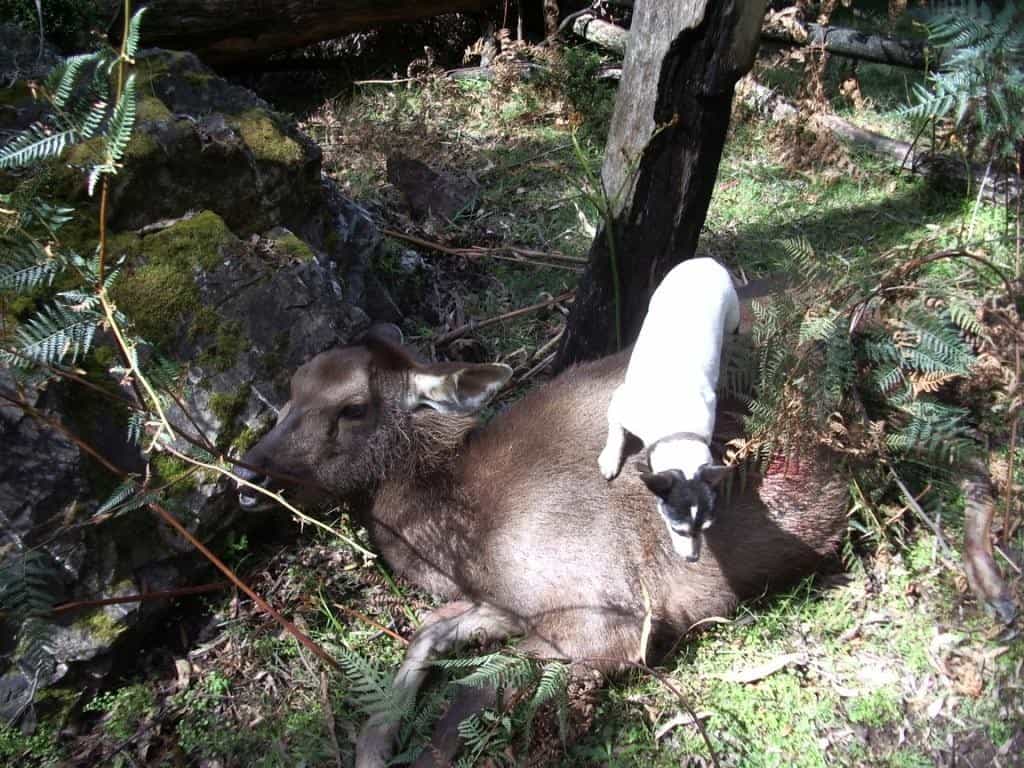
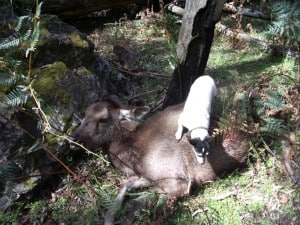
Pingback: 13 Things That Make The Sambar Deer A Survival Specialist
Thanks for the link. Cheers, Steve
Hi Steve, I’m the fellow who contacted you last year asking if you thought a 30-30 would do the job on Sambar. Well, I’m happy to say you were right (and a lot of the naysayers were wrong). I just returned from a trip to the Biggara Valley area where I harvested two good-sized hinds with my Marlin 336, fitted with a Skinner aperture sight. My mate also harvested a medium-sized stag with his .308 with fibre-optic open sights. We have enough meat for a year! Thanks for all your advice, such as not wearing camo clothing. I read pretty much all of your deer-hunting posts, and I an honestly say that I have you to thank more than anyone else for my success on the recent trip. Paul.
I am really pleased you have had such hunting success Paul. I have not been to that area but there are so many mountain places like that I long to see. Even though Victoria is a relatively small state you could spend almost a lifetime just exploring a small river valley – like the Tyers I just posted about. I suspect the 30:30 and the .303 have still taken almost as many sambar as many of the more modern rounds. If you punch a .3″ hole in something’s chest with a projectile going a couple of thousand feet per second it is really academic as to whether it is going to be more dead if another round is a fraction of an inch bigger or going a couple of feet faster! Three things I like about the 30:30: the buckhorn sights. They are so clear and so good on running deer. Aperture sights are great too. Its lightness. The fact that you can carry it around all day without a bullet in the breech yet have a shot away as soon as it hits your shoulder and another a fraction later before the deer has gone ten yards. I am so pleased you wrote today with such kind words. I am a bit down in the dumps over an awful fencing dispute with a diabolical ‘tree-change’ new neighbor who will not consider replacing the boundary fence which was flattened by the flood a month ago. This season we have nothing to protect our lambs from being wiped out by foxes and look set to lose most of our year’s livelihood. So you have cheered me up a lot. Thanks a million. Hope you continue to have hunting success and enjoy the bush for many years to come. I also hope you get into my ultralight deer hunting ‘system’. It is so great to be able to get away to really remote areas where you feel that you were the first man in creation. Cheers, Steve.
Hi again Steve,
Sorry for my late reply – I have four little kids and time is short! Tree-changers can certainly be a nuisance – I have friends in an area which is full of the Green-left, latte-sipping, soy-munching variety. I have sympathy for some of their ideas – of course we should look after our world, for example, and who doesn’t like a coffee – but they can be a pretty narrow-minded and Puritanical bunch. Still, I suppose I shouldn’t generalise. I hope your livelihood wasn’t in fact ruined by the lack of a fence. To return to hunting talk: Thanks for your encouragement. Without it we might have ended up with camo clothing, expensive gear, big scopes, and no deer hehe. We are also certainly considering to get into your “system”; the aim for next year is a backpack hunt. Since our successful trip, I find myself offering other hunters advice (which is all your advice really)! I have also now emulated you by ordering a BLR .308 (I love lever guns, so why not?) and will go for another aperture sight. I also bought an Enfield No.4 (which has an aperture sight – I’m sensing a pattern here hehe). I’m hoping that both rifles will taste success in the years to come. Keep doing what you are doing Steve, your blog is a treasure. Paul
Your reply means so much to me Paul. The fencing dispute has morphed into a nightmare which is costing us (tens of) thousands of dollars. I am unable to mention it at present. Lambing is still going fairly well considering we have a major boundary fence missing. I am so glad you are having success with your hunting. As well as getting into some ultralight backpack hunting, when you find a spot (probably in the middle of a ‘wilderness area in a national park) where you can have it more or less to yourself you might think about constructing an ultralight wilderness hut. The old .303 will still stop a lot of deer and is such a safe/reliable action (and sights). I do love my BLR though. I am seriously considering whether I can lighten it with a carbon fibre barrel and stock. Probably could reduce its weight by a kilo. I do hope to be able to keep up my blog Paul. I have had some difficulty with its version on Facebook lately and cannot update it as Facebook seems to have ‘forgotten’ my link to it. This is because someone hacked my Facebook account and I had some difficulty getting it back. A lot of things are not going very well at the moment but will pick up some time in the future and Della and I will be bale to get back out in the bush enjoying ourselves. ‘Next year Jerusalem’ as the saying goes. Cheers, Steve & Della Jones.
Thank you. A well written article indeed. I will try out the suggestions this weekend.
Good luck hunting Raj. PS: There are many other thoughts about deer hunting on my website. The most recent one is here: https://www.theultralighthiker.com/2020/06/06/ultralight-ultracheap-deer-hunting-a-ripping-yarn-or-two/
Thank you so much for the great read. Very helpful for a beginner like me. Very much appreciated mate.
Thank you Peter. Glad you enjoyed. Goo luck with the hunting. Cheers Steve.
Bravo. Truly a great resource and so very well written. As a newcomer to Sambar hunting l greatly appreciate the intel you have provided. Having hunted only Fallow deer to date around Kingston SE, it is already clear from this article that Sambar behave somewhat different ly to Fallow, and in a completely different type of environment. Thank you once again for sharing your wisdom-gained experiences.
Thank you for your support Peter. Hope you find the other 1200 or so posts equally useful. Good luck with your sambar hunting. Cheers, Steve.
Thanks so much. I grew up shooting foxes, pigs, rabbits in the 70s and 80s and now my 14yo son is prepared to start hunting. I am guided by him, he has no desire for trophy, only meat and spending time out bush together…and grandad is fizzing at the bung in anticpation of a shoot with his son and grand son. Thanks, i’ll be following your blog from now on.
Glad you enjoyed it, Pete. Good luck to you both!
Excellent article. Thanks.
Thank You!
I have to disagree with your choice in eating qualities of deer and fish, I personally love to eat fish, but not so keen on freshwater fish which i find tend to taste muddy compared to flathead, snapper etc , I do love my venison though and find any Venison from a hind or spiker to be great eating. I suppose though taste is a personal thing and you may like the trout if it pleases you. 🙂
I do enjoy those saltwater fish too – but we not only have trout (much nicer from clean mountain rivers), but also blackfish and freshwater crays. However, ‘May we all eat lamb in Paradise’ as the hero of ‘The Wind & the Lion’ declaims!
What a fantastic article! Very well written.
Thank you Carlo!
Gold thanks for the info
Thank YOU Darren!